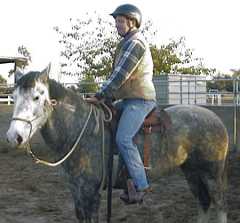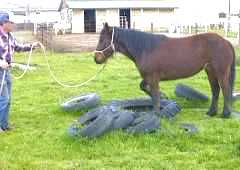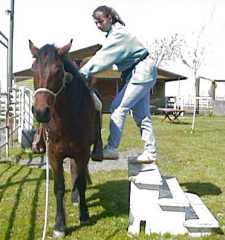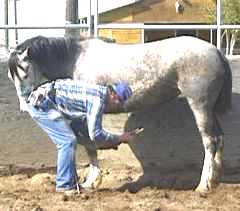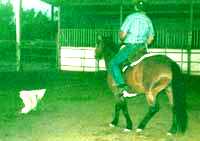Gentling Wild Horses,
|
"Keno the Untrainable"
|
|
Original publication: February 10, 1998 Updated July 31, 2012 Please note: This feature was originally presented as part of our "Wild Horse Help Desk" material for new wild horse adopters. However the same principles apply when approaching and attempting to handle stressed, injured or overly emotional horses, and in emergency situations where it is necessary to restrain and/or relocate a horse.
One of the interesting things which we have observed is how often adopters with little or no prior horse experience oftentimes are more successful in gentling their horses than adopters who have handled domestic horses. It seems that wild horses don't care much for the preconceived notions of folks who think they know what horses are all about based on their experience with domestics. Those adopters who are more interested in figuring out what makes their wild horses tick seem to catch on to the elements to which wild horses respond. This section is designed to encourage prospective and help new adopters assume the best mindset for gentling and training their new horses The A-B-Cs of wild horse gentling Accept the horse for what he is. You have a wild horse. He's not a child or a puppy or even a domestic horse. He has instincts, naturally reinforced responses and both social and physical needs. Wild horses have individual horsonalities based on their age, sex, bloodlines and environmental and social experiences. Their individual strengths and difficulties have to be taken into account until they learn how to cope and flourish in the human environment. Be respectful of the horse. Your horse didn't ask to be here. Living with you is not his dream. His life in captivity may well be more pleasant for him overall than survival in the wild, but it will be a while before he realizes this. Respect his needs including the fact that a horse needs consistent, competent and fair leadership which is recognizable in his terms in order for him to be comfortable in unfamiliar and stressful situations. Consistency is important for a newly adopted horse. Your horse is in a new and strange environment. He doesn't understand domestic routines and the behavior of humans. Doing things in such a manner as to portray a consistent "cause and effect" will help the horse understand his new surroundings. In saying this we don't mean that you should bore the horse to death with mindless repetition. In fact as the horse becomes more confident and understands what's going on, we prefer to avoid ritualistic routines. However, the horse first has to become well grounded as to how things work and if what he experiences is consistent, he'll catch on faster and more solidly. (For visitors concerned with handling horses in volatile and stressful situations, the same basic psychological elements apply. If left to his own devices, a horse would likely simlply leave a stressful situation. When leaving is not possible, one must consider that stress will increase in the animal and he could react explosively.) Continue to Part 2 |
The photos on this page are of horses that could not be handled.Approaching scary things
|
Press "Back" to return to the page which brought you hereGo to KBR Training SectionGo to LRTC Wild Horse MentorsGo to KBR World of Wild Horses & BurrosGo to other Wild Horse LinksGo To
| |

